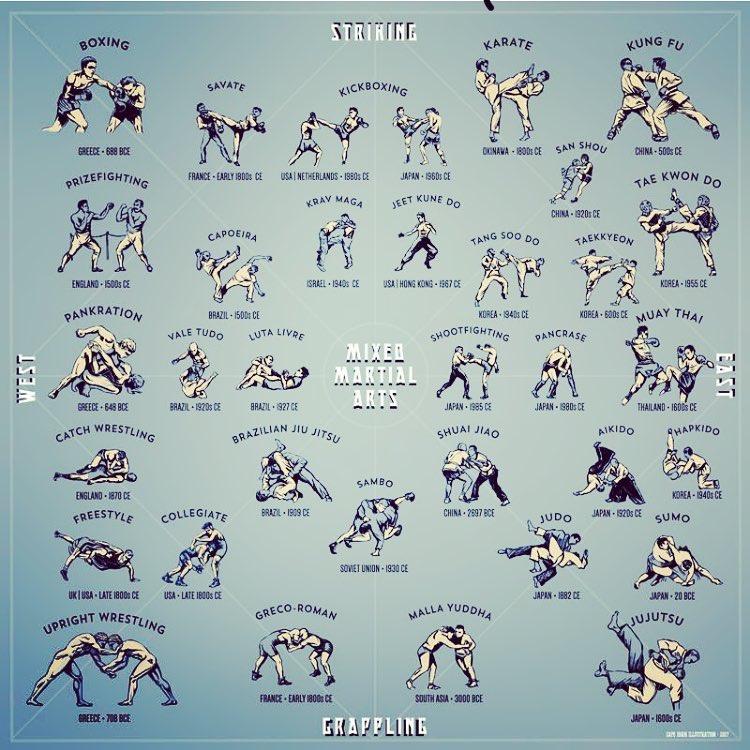Discovering The Rich Heritage And Spiritual Capacities Of Martial Arts
Discovering The Rich Heritage And Spiritual Capacities Of Martial Arts
Blog Article
Content Develop By-Lauridsen Patterson
Enter the ancient globe where martial arts were born out of necessity in diverse regions. Cultures crafted distinct combating styles intertwined with historic contexts. Techniques evolved over centuries via dedicated method and social exchanges. Today, modern martial arts mix typical components for maximum efficiency. Philosophically, martial arts stress discipline, self-improvement, and harmony. Regard, humbleness, and balance are fundamental principles directing professionals in the direction of development and durability. Discover the depths of this abundant background and philosophy to uncover the extensive influences shaping this long-lasting technique.
Origins of Fighting Style
Fighting style originated in various regions around the world, advancing as practical combat systems to defend against risks. These old fighting styles were created out of necessity, with each culture crafting methods suited to their distinct environments and obstacles. From the grappling arts of Jujutsu in Japan to the striking methods of Kung Fu in China, martial arts were deeply linked with the historical, social, and cultural fabric of their respective cultures.
In Japan, the samurai course refined martial arts like Kenjutsu, the art of the sword, which later evolved into the much more promoted form of Kendo. Meanwhile, in Brazil, Capoeira became a blend of dancing and fight, created by enslaved Africans as a way to stand up to oppression. Each fighting style carries with it an abundant history and philosophy, mirroring the worths and ideas of individuals that exercised them.
As you explore the beginnings of martial arts, you uncover a tapestry of human resourcefulness, resilience, and the stubborn spirit of warriors throughout time.
Advancement of Techniques
With centuries of practice and improvement, battle methods within different martial arts have gone through an extensive development. From ancient designs like Kung Fu and Martial arts to a lot more modern-day disciplines such as Brazilian Jiu-Jitsu and Krav Maga, the development of strategies has actually been driven by a mix of cultural impacts, useful applications, and technological innovations.
One considerable element of this development is the cross-pollination of strategies in between different martial arts. For example, strategies from traditional Japanese Jiu-Jitsu were incorporated right into the development of Judo by Jigoro Kano in the late 19th century. This mixing of styles has actually resulted in the advancement of crossbreed martial arts like Mixed Martial Arts (MMA), which incorporate elements of striking, grappling, and submission methods.
Furthermore, the development of techniques has been formed by the increasing focus on efficiency and effectiveness in fight. Professionals have actually continuously looked for to improve their techniques through extensive training, experimentation, and competition, resulting in the development of highly specialized and reliable battling styles. Generally, the development of techniques in martial arts shows the vibrant nature of fight and the ongoing pursuit for improvement and advancement.
Philosophical Foundations
Discovering the underlying philosophical principles of martial arts provides understanding into their core values and guiding ideas. At autism friendly martial arts near me of lots of martial arts self-controls is the concept of discipline itself. By educating your mind and body to work as one cohesive unit, you cultivate discipline that extends beyond the dojo or health club into day-to-day life. This technique encompasses regard, humbleness, and self-constraint, shaping not simply your physical abilities but likewise your character.
An additional essential thoughtful structure in martial arts is the concept of continual self-improvement. go to this website of understanding a fighting style is perpetual, with professionals constantly aiming to far better themselves, both physically and mentally. This focus on growth promotes resilience, willpower, and a growth attitude that can be applied to all elements of life.
Furthermore, martial arts stress the value of harmony and balance. Methods are designed to use an opponent's power versus them, highlighting the principle of producing and rerouting pressure as opposed to fulfilling it head-on. This ideology includes social connections, advertising peaceful resolutions and good understanding. By welcoming these philosophical structures, martial musicians not only boost their fight abilities yet also cultivate a lifestyle fixated personal growth, regard, and consistency.
Conclusion
In conclusion, the history and philosophy of martial arts offer an abundant tapestry of practice, self-control, and self-improvement.
Take for instance the tale of Bruce Lee, who transformed martial arts by blending various designs and approaches to produce his own one-of-a-kind kind of Jeet Kune Do.
With dedication and development, martial musicians remain to push limits and motivate others to reach their full capacity both in battle and in life.
